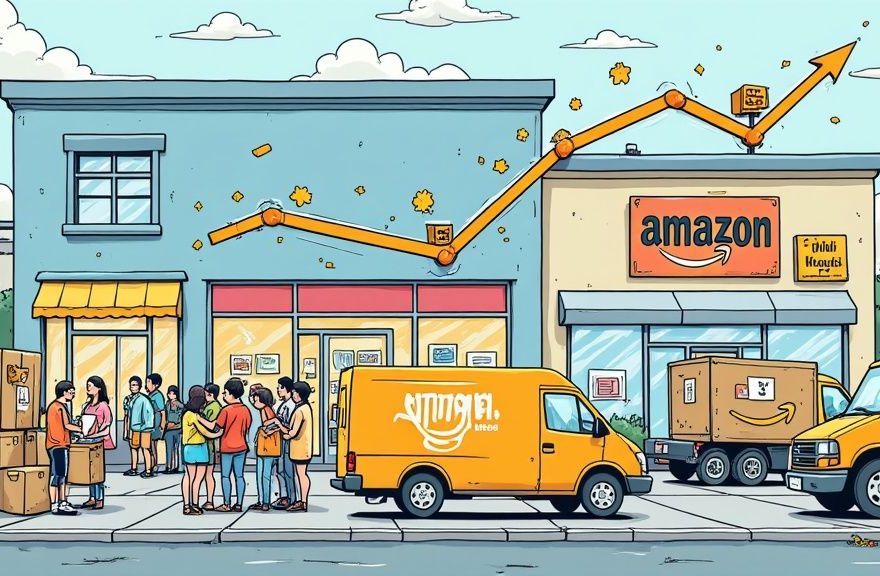Understanding the Modern Amazon Marketplace

Success on Amazon requires more than just listing products – it demands a deep understanding of how the marketplace works. The most successful sellers look beyond basic tactics to identify what drives sales and customer behavior. They’re constantly fine-tuning their approach based on real marketplace dynamics.
Identifying Key Market Trends
Knowing your target customer is essential for Amazon’s success. Are your products aimed at price-sensitive shoppers looking for deals, or customers willing to pay more for premium quality? Beyond this, you need to track broader consumer behaviors – for instance, more shoppers now prioritize eco-friendly products and prefer mobile shopping. Understanding these patterns helps position your products effectively.
The Power of the Prime Customer
Amazon Prime members represent a massive opportunity for sellers. With 230 million subscribers worldwide and 165 million in the US alone, Prime customers are some of the most active shoppers on the platform. Recent data shows that Prime members shop more frequently and spend significantly more than non-Prime customers. Smart sellers tailor their strategies to appeal to this valuable customer base.
Leveraging Amazon’s Ecosystem
The best sellers treat Amazon as more than just a sales channel – they build authentic brands that resonate with customers. This means developing a clear brand identity, focusing on customer relationships, and using Amazon’s tools strategically. Think of it as creating a unique storefront that stands out in a crowded shopping center.
Adapting to Algorithm Changes
Staying current with Amazon’s search algorithm updates is crucial for maintaining visibility. The algorithm determines which products appear first in search results, directly impacting your sales potential. Successful sellers monitor these changes closely and adjust their listings accordingly. This proactive approach helps ensure steady growth even as the marketplace evolves.
Mastering Fulfillment for Maximum Growth
Getting fulfillment right is essential for success on Amazon. It’s not just about shipping boxes – it’s about giving customers such a seamless experience that they keep coming back for more. When you nail your fulfillment strategy, you build trust and loyalty that fuels sustainable growth.
Choosing the Right Fulfillment Method
Amazon sellers have two main options for getting products to customers. With Fulfillment by Merchant (FBM), you handle everything yourself – storing inventory, packing orders, and shipping them out. This works well for small businesses that want full control, though it requires significant time and resources. The other option is Fulfillment by Amazon (FBA), where Amazon handles storage, packing, and shipping for you.
FBA can be a game-changer for growing your business. Sellers who use FBA typically see sales increase by 30-50% compared to handling fulfillment themselves according to recent data. This boost comes from the trust customers place in Amazon’s fast shipping and reliable service. FBA also frees up your time to focus on product development and marketing. Plus, FBA products are Prime-eligible, which can dramatically impact purchase decisions since many shoppers filter specifically for Prime items.
Optimizing Inventory Management
Smart inventory management prevents two costly problems – running out of stock and tying up too much cash in excess inventory. Think of it like keeping your kitchen stocked: too little means disappointed customers, while too much leads to waste. The key is using data to forecast demand accurately. A good inventory management system helps you spot sales patterns and adjust stock levels at the right time, preventing both stockouts and overstocking.
Scaling Fulfillment Operations
As orders increase, your fulfillment needs to keep pace without sacrificing quality. This might mean adding warehouse space, bringing in automation tools, or working with third-party logistics providers (3PLs). The goal is growing sustainably – making sure you can handle higher volume while maintaining quick, accurate delivery. For example, during holiday rushes, you might need temporary staff or extra storage space. Getting these basics right creates a strong foundation for expanding your Amazon business.
Creating High-Converting Product Listings

Getting more sales on Amazon comes down to one key thing – product listings that turn browsers into buyers. Smart sellers know it’s not just about listing features – you need to present your product in a way that makes people want to buy. The best listings blend search-friendly keywords with compelling copy that ranks well and gets clicks.
Crafting Compelling Product Titles
Think of your product title as your storefront window display – it needs to immediately grab attention and pull people in. A good title includes relevant search terms while clearly showing what makes your product special. For instance, instead of a basic “Blue Widget”, try something like “Durable Blue Widget: Heavy-Duty Build for Years of Use”. This tells shoppers exactly what they’re getting and why they should care.
Writing Bullet Points That Drive Purchases
Your bullet points need to quickly show shoppers why they should choose your product. Frame each point around what’s in it for the customer – how will this make their life better? Some tips for strong bullet points:
- Lead with Benefits: Rather than “Made with stainless steel,” say “Rust-proof stainless steel means you’ll never need to replace it”
- Be Specific: Instead of “Easy setup,” try “Set up in under 5 minutes with no tools needed”
- Add Numbers: “Fits items up to 50 pounds” beats vague terms like “high capacity”
Good bullet points paint a clear picture of how the product solves problems and delivers value.
Product Descriptions: Addressing Customer Concerns
Your product description is where you can dive into details and handle any questions shoppers might have. Think about what would make someone hesitate to buy, then directly address those concerns. Give them all the information they need to feel confident hitting that buy button. Clear, honest descriptions build trust and boost sales.
A+ Content: Elevating Your Brand
For brand-registered sellers, A+ Content offers powerful tools to showcase products through images, comparison charts, and enhanced formatting. A well-designed A+ page with product demos and comparison tables can significantly boost conversion rates. This premium content helps tell your brand story and highlight your product’s unique value in a visually engaging way. By optimizing every part of your listing – from title to A+ Content – you transform interested shoppers into confident buyers.
Developing a Winning Pricing Strategy
Smart pricing makes the difference between mediocre and exceptional Amazon sales. Finding the right price point goes beyond simply matching competitors – it requires a careful balance of profitability and market positioning. Here’s how to develop an effective pricing approach that drives sustainable growth.
Data-Driven Pricing Decisions
The most successful Amazon sellers let data guide their pricing choices. By using tools that monitor competitor pricing, sales patterns, and inventory levels, you can pinpoint optimal prices that attract buyers while protecting margins. For example, when data reveals higher demand for beach gear in summer months, you can adjust prices upward to capture that seasonal opportunity.
Maintaining Buy Box Ownership
The Buy Box – that “Add to Cart” button on product pages – is essential for real estate since most purchases happen through it. Your chances of winning it improve with competitive pricing, using Fulfillment by Amazon (FBA), and strong seller metrics like fast shipping and positive reviews. Focus on delivering great service and smart pricing to secure this prime placement.
Implementing Dynamic Pricing
Dynamic pricing lets you flex prices in real-time as market conditions change. Think of it like steering a ship – you need to respond to shifting winds (market forces) to stay on course. While automation tools can handle the constant monitoring and updates, be sure to set price floors that protect your profitability and prevent unsustainable price wars.
Strategic Use of Promotions
Well-timed promotions through coupons and lightning deals can boost visibility and sales. But use them sparingly and strategically to avoid hurting your bottom line. For best results, align promotions with key selling periods like holidays or product launches. A targeted discount on a new item can help attract early customers and build momentum.
Seasonal Adjustments and Competitive Positioning
Your pricing should adapt to natural demand cycles throughout the year. Peak seasons often support modestly higher prices, while slower periods may require promotional pricing to maintain sales velocity. Study competitor pricing to understand where you fit in the market. Whether you position as a premium or value option, your pricing should consistently reflect that choice to attract your ideal customers.
Building a Review Generation Engine

Getting real reviews from happy customers can make or break your success on Amazon. These reviews build credibility and help new shoppers feel confident buying your products. Let’s explore proven ways to encourage genuine reviews while following Amazon’s rules.
Why Reviews Matter on Amazon
Think of reviews as word-of-mouth recommendations at scale. When shoppers see lots of positive feedback from real buyers, they’re more likely to trust your product over competitors with few or negative reviews. This is especially important when launching new items in crowded categories. Just like reading restaurant reviews before trying a new place, Amazon customers rely heavily on reviews to guide their purchases.
Strategies for Generating Authentic Reviews
The key is being proactive about reviews while staying within Amazon’s guidelines. Here are some effective approaches that work:
- Product Inserts: Add simple thank you cards in your packaging that politely ask for feedback. Keep the language natural and avoid offering incentives, which breaks Amazon’s rules.
- Follow-Up Emails: Send a friendly post-purchase note to thank customers and welcome their honest feedback. Make these emails personal and focus first on being helpful.
- Early Reviewer Program: For new products, Amazon’s program can help get initial reviews from verified buyers. Note that availability varies and Amazon (not sellers) provides any rewards.
- Customer Service: While you can’t directly ask for reviews in Buyer-Seller messages, providing great service often leads to happy customers leaving positive feedback naturally.
Handling Negative Reviews
Every product gets some negative reviews eventually. The important part is how you respond. Address criticism professionally, offer solutions, and show future buyers that you take feedback seriously. A thoughtful response to a critical review can boost shopper trust.
Building a Feedback Loop
Reviews provide valuable insights to help improve your products over time. Look for patterns in both positive and negative feedback. Use this information to make your products better and give customers more of what they want. This creates an ongoing cycle of improvements.
Monitoring Your Product’s Reputation
Keep regular tabs on your review ratings and overall feedback. Several tools can help track reviews automatically and alert you to concerning trends. Staying on top of your product’s reputation lets you address any issues quickly and maintain the positive image that drives sales.
Maximizing ROI Through Amazon Advertising

Getting real results from Amazon Advertising takes more than just spending money on ads. Success comes from carefully planning your approach and continuously improving your campaigns based on data. Let’s look at proven strategies that help sellers boost their visibility and profits.
Structuring Campaigns for Success
Think of your campaign structure like building a house – you need a solid foundation. This means organizing your ads logically around product categories and relevant keywords. For instance, if you sell both kitchenware and garden supplies, create separate campaigns for each. This targeted approach gives you better control over bidding and messaging for different product lines.
Advanced Targeting Techniques
Running ads without proper targeting is like fishing without knowing where the fish are. Advanced targeting techniques help focus your budget on reaching the right customers. Using product ASIN targeting and negative keywords filters out irrelevant searches, ensuring your ads reach shoppers most likely to buy. This precision approach helps avoid wasted ad spend.
Bid Optimization Strategies
Finding the right bid level is crucial for your ROI. Bid too low and your ads get buried; bid too high and profits suffer. The key is regularly reviewing performance data and adjusting bids to maintain a profitable Advertising Cost of Sale (ACOS). Stay competitive while protecting your margins through ongoing optimization.
Scaling Successful Campaigns
When you find campaigns that work well, expand them strategically. Don’t just increase budgets across the board. Instead, add relevant keywords, test new ad types, and target related products. Monitor performance closely as you grow. Like nurturing a garden, give your campaigns the right resources at the right time.
Combining Ad Types and Measuring Impact
Mix different ad formats to reach customers throughout their shopping journey. Using Sponsored Products, Sponsored Brands, and Sponsored Display ads together creates better visibility. Track key metrics like click-through rate (CTR), conversion rate, and ACOS to understand what’s working. Use this data to keep improving campaign performance.
Success with Amazon Advertising comes from constant testing and refinement. Focus on targeted campaigns, smart bidding, and data-driven decisions to grow your sales effectively.
Looking to boost your Amazon business? eStore Factory brings over a decade of experience as a three-time Amazon SPN Award Winner. Our team of 70+ Amazon experts has helped generate more than $250 million in sales for over 5,000 brands. From optimizing listings to managing ad campaigns, we provide complete solutions for Amazon success. Visit eStore Factory to learn how we can help grow your business.

